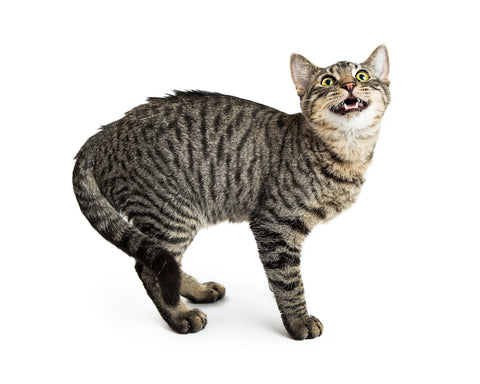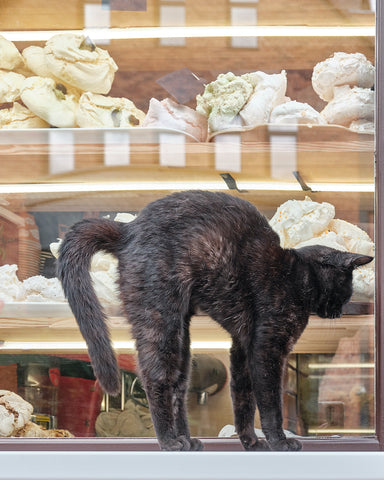Why Do Cats Arch Their Back? A Closer Look at the Arched Back
Cats are fascinating creatures with a plethora of behaviors that often leave us intrigued and curious. One such behavior that has puzzled cat owners for centuries is the distinctive arching of their backs.
In this article, we delve into the reasons behind this common feline gesture, exploring the various meanings and contexts in which cats exhibit this behavior.
Decoding the Cat Arch: Understanding the Mystique Behind Feline Back Arches
The Many Reasons Why Cats Arch Their Backs
Communication and Body Language:
Cats are known for their subtle yet effective communication skills, and the arching of their back is no exception. When a cat arches its back, it often signifies a form of communication. This gesture can convey a range of emotions, from fear and submission to excitement and anticipation. Understanding the context and accompanying cues can help decipher the specific message your feline friend is trying to convey.
Stretching and Flexibility:
Cats are natural gymnasts, and their bodies are designed for agility and flexibility. Arching the back is a common part of a cat's stretching routine. By doing so, they engage and stretch their muscles, promoting blood circulation and maintaining their overall physical well-being. Observing a cat arching its back after waking up or during playtime is often a sign of this instinctual stretching behavior.
Territorial Marking:
Cats have scent glands along their spine, and arching the back allows them to spread their unique scent onto surfaces. This behavior is a way for cats to mark their territory and establish a familiar scent in their environment. Understanding this aspect of feline behavior can shed light on why your cat might arch its back in certain areas of your home.

Emotional Responses:
Cats are known for being emotionally expressive, and their body language is a key indicator of their feelings. Arching the back can be a response to various emotions, including excitement, curiosity, or even aggression. By paying attention to other cues such as tail position, ear movement, and vocalizations, cat owners can better interpret the specific emotion behind the arching behavior.
Self-Defense Mechanism:
In some cases, arching the back is a defensive posture that makes a cat appear larger and more intimidating to potential threats. This instinctual response is often accompanied by raised fur, a puffed-up tail, and a sideways stance—all serving as a means of self-protection.
Playful Behavior:
Cats are playful creatures, and the arching of the back can also be associated with playfulness. During interactive play sessions, a cat may arch its back as a way of expressing excitement and engagement. This behavior is often accompanied by other playful actions such as pouncing, batting, and a flicking tail.
Mating Behavior:
In the context of mating and courtship, female cats may arch their backs as part of a receptive posture. This behavior is a signal to male cats that they are open to mating. Understanding these natural reproductive behaviors can be crucial for cat owners who have unspayed female cats or are considering breeding.
Health Issues:
While arching the back is usually a normal and healthy behavior, persistent or sudden changes in this posture could indicate underlying health issues. Pain or discomfort, especially in the spine or abdominal area, may cause a cat to arch its back. If you notice any unusual or prolonged changes in your cat's behavior, it's essential to consult with a veterinarian to rule out any potential health concerns.
Social Hierarchy and Dominance:
In multi-cat households or environments where cats interact with other animals, the arching of the back can be a display of social hierarchy. A dominant cat may arch its back to assert its position and establish boundaries, while a more submissive cat might adopt a lowered posture to show deference.
Age-Related Behavior:
Kittens often display exaggerated arching behavior during play, exploration, and interactions with their mothers. As cats grow and mature, this behavior may become more subtle but can still be observed in various contexts. Understanding the developmental aspects of arching behavior can provide insights into your cat's changing needs and behaviors over time.
The arching of a cat's back is a multifaceted behavior that serves various purposes, from communication and stretching to expressing emotions and maintaining social dynamics. By observing and interpreting this behavior in different contexts, cat owners can deepen their understanding of their feline companions and create a more enriching environment that caters to their physical and emotional needs.
As with any aspect of cat behavior, patience, observation, and a keen eye for nuances are key to building a strong and harmonious bond with these enigmatic creatures.
What to Do If Your Cat is Arching Its Back and Seems Distressed?
If your cat is arching its back and displaying signs of distress, it's important to take prompt action to identify and address the underlying cause.
Here are some steps you can take:
Observe Carefully:
Pay close attention to your cat's overall behavior, body language, and any other visible signs of distress. Look for changes in appetite, litter box habits, grooming behavior, and vocalizations.
Check for Immediate Dangers:
Ensure that your cat is not in immediate danger. If there are potential hazards in the environment, remove them to prevent further stress or injury to your cat.
Examine for Injuries:
Gently and carefully check your cat for any signs of injuries, swelling, or tenderness. If you notice any wounds, bites, or lumps, contact your veterinarian for guidance on how to proceed.

Assess for Pain:
Arching the back can be a sign of pain or discomfort. If your cat allows, gently touch and palpate different areas of its body, paying attention to any reactions such as flinching, hissing, or avoiding certain areas. If you suspect pain, consult your veterinarian for a thorough examination.
Check for Hair Matting or Skin Issues:
Long-haired cats, in particular, may experience discomfort or distress if their fur becomes matted or if they have skin issues. Examine your cat's coat for any matting, ticks, fleas, or signs of skin irritation.
Evaluate the Environment:
Consider any recent changes in the environment that may be causing stress to your cat, such as new pets, changes in routine, or the introduction of new objects. Cats can be sensitive to changes in their surroundings, and stress can manifest in various ways.
Consult with a Veterinarian:
If your cat's distress persists or if you are unable to identify the cause, it's crucial to seek professional veterinary advice. A veterinarian can conduct a thorough examination, perform diagnostic tests if necessary, and provide appropriate treatment for any underlying medical issues.
Create a Comforting Environment:
Once immediate concerns are addressed, create a quiet and comfortable space for your cat to relax. Ensure access to food, water, and a clean litter box. Minimize stressors in the environment and provide a familiar and soothing atmosphere.
Follow Veterinary Recommendations:
If your veterinarian identifies a specific issue, follow their recommendations for treatment, medication, or any necessary follow-up care. Administer medications as prescribed and attend any scheduled veterinary appointments.
Remember, the health and well-being of your cat should be a top priority. If you ever have concerns about your cat's behavior or health, don't hesitate to consult with a veterinarian for professional guidance tailored to your cat's individual needs.
Leave a comment
